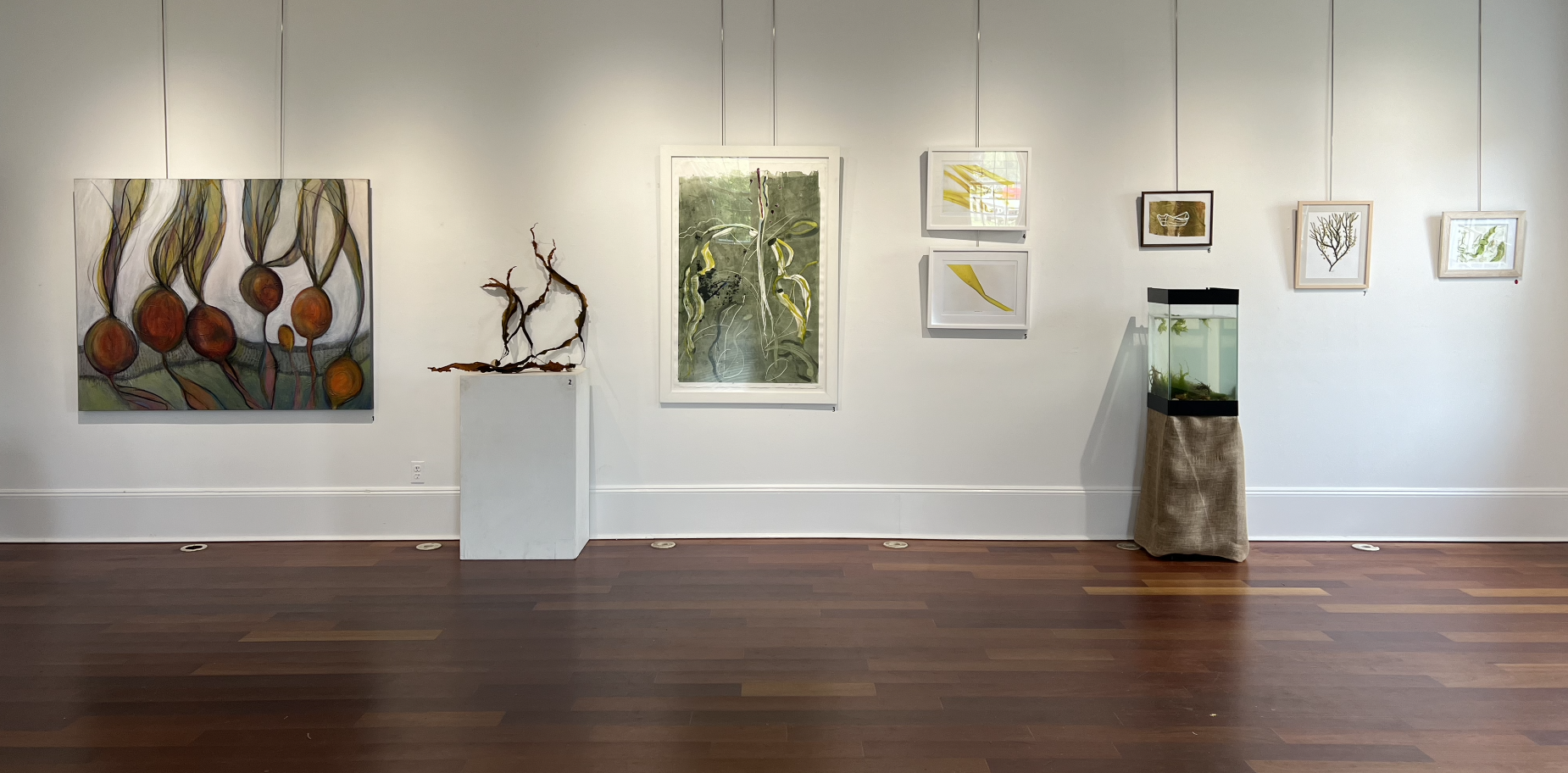Celebrating Seaweed: Our Art and Awareness Event
Back to the Bays is thrilled to share the success of our recent art and awareness event, This is Seaweed, hosted at Ashawagh Hall in East Hampton. The opening reception on July 19th was a remarkable evening, with a tremendous turnout and an incredible show of support for our Back to the Bays Seaweed Initiative.
Attendees of the opening reception in front of Adriana Barone’s artwork (left), opening reception (middle), Idonline Duke’s “Sea Lettuce Imagined” followed by Carolyn Munaco’s “Sea the Weed” (right)
My name is Ella Gatfield, and I am Back to the Bays’ Marine Educator and curator of This is Seaweed. As I took in the gallery before the opening reception, I was struck by the sheer talent and dedication of the artists who contributed their work. Even while curating the show - ranging from paintings to kelp lamp shades - seeing the pieces come together to create a cohesive story was truly impactful. Also included were: stunning seaweed pressings created by students of John Marshall Elementary; evocative prints, collages, and mixed media works by local and professional artists; a living seaweed tank; seaweed-inspired driftwood sculptures; seaweed dyed textiles; microscopic photographs of seaweed. Each artwork told a story of our vital connection to macroalgae and the marine environment.
In order starting with Kryn Olson’s “Peconic Bay” (left), Scott Bluedorn’s dried kelp on rock, Mimi Saltzman’s “Seaweed”, Sutton Lynch’s “Seaweed Abstract” I and “Seaweed Abstract II”, Scott Bluedorn’s “kelpie”, Ella Gatfield’s floating seaweed tank, Carolyn Munaco’s “Bladderwrack”, Kim Barbour’s “Weed Waves”
The enthusiasm and energy in the room were palpable, as attendees engaged with the art and learned about the importance of Back to the Bays efforts in improving water quality. The show focused on our recent work remediating Hog Creek, a waterbody in Springs, NY. Through East Hampton Town’s Community Preservation Fund, we have been able to improve the water quality of Hog Creek by lessening groundwater nutrient inputs.
Excessive nutrient inputs - like nitrogen - can cause algae blooms. Green macroalgae, particularly Ulva lactuca (sea lettuce) responds fastest, reproducing rapidly through fragmentation, forming a ”mat” on the bottom and outcompeting benthic plants. Macroalgae ultimately decomposes, reducing oxygen and releasing nitrogen back into the waterbody, continuing the cycle. These eutrophic conditions threaten the health of marine ecosystems. CCE Marine Program used site characterization to plan the instillation of Permeable Reactive Barriers (PRBs) that remove a significant amount of nitrogen from the groundwater before it loads into the waterbody. Back to the Bays also uses various methods of bio-extraction to remove sea lettuce before it decomposes. Lastly, we are raising awareness regarding this topic through education and outreach strategies - including meeting with students at John Marshall, public events such as This is Seaweed, and speaking with home owners about lawn fertilizers, septic practices, permeable reactive barriers, and developing living coastlines.
John Marshall’s seaweed prints (left), fresh seaweed from Hog Creek (middle), Kryn Olson’s “Peconic Bay” (right)
I want to extend my deepest gratitude to all the artists who participated in This is Seaweed. Your creativity and commitment have made a meaningful impact, and your artwork will continue to inspire and educate others about the importance of our marine ecosystems. Special thanks to Kidd Squid and Borghese Vineyard for providing delicious beverages that made our reception even more enjoyable. It was heartening to see so many people come together to support our mission. Thanks to the generous contributions of our artists and the support of our community, we were able to raise funds that will directly benefit our coastal and marine research and restoration on Long Island.
This event was more than just an exhibition; it was a celebration of the power of art and science to drive positive change. Whether collaborating with science students on water quality and seaweed prints or discussing kelp with artist Scott Bluedorn, the intersection of art and science has proven to be a powerful force for raising awareness and fostering community engagement.
John Haubrich “Untitled I” and “Untitled II”, Scott Bluedorn’s “Polygon Lamp, Kate Salke’s “Mother” (top left), Scott Bluedorn with fresh kelp photographed in front of Perry Burn’s “Magic Hour” (top middle) , Ella Gatfield’s “Searching for Seaweed” and Roisin Bateman’s “Sea Walk” and “Sea Walk II” (top right), Gray Berger’s “Untitled I” and “Untitled II” (bottom left), Bran Dougherty-Johnson’s three driftwood sculptures “Graceful Redweed”, Kelp and Lettuce”, and “Fish & Deadmans Fingers” and Eliza Gatfield’s seaweed textiles “Seaweed Spirals I” and “Seaweed Spirals II” (bottom middle), Kate Kavanaugh’s “Prayers from the Sea” followed by Remi Berger’s “Alga Lucerna I” and “Alga Lucerna II” (bottom right)
As we look ahead, I am excited about our upcoming community harvest event in East Hampton where participants will be removing sea lettuce from Hog Creek before it decomposes. This will be another opportunity for us to come together, learn, and contribute to the health of our local waters. Stay tuned for more details, and in the mean time read up on our current and past Back to the Bays Seaweed Initiative efforts here: https://backtothebays.org/seaweed-macroalgae.
Thank you once again to everyone who made This is Seaweed a resounding success. Together, we are making a difference for our environment and our community.
Ella Gatfield (left), Back to the Bays college intern Sam Olweck, Back to the Bays ArtSEA Program Director, and Back to the Bays Marine Educator Ella Gatfield (right)














